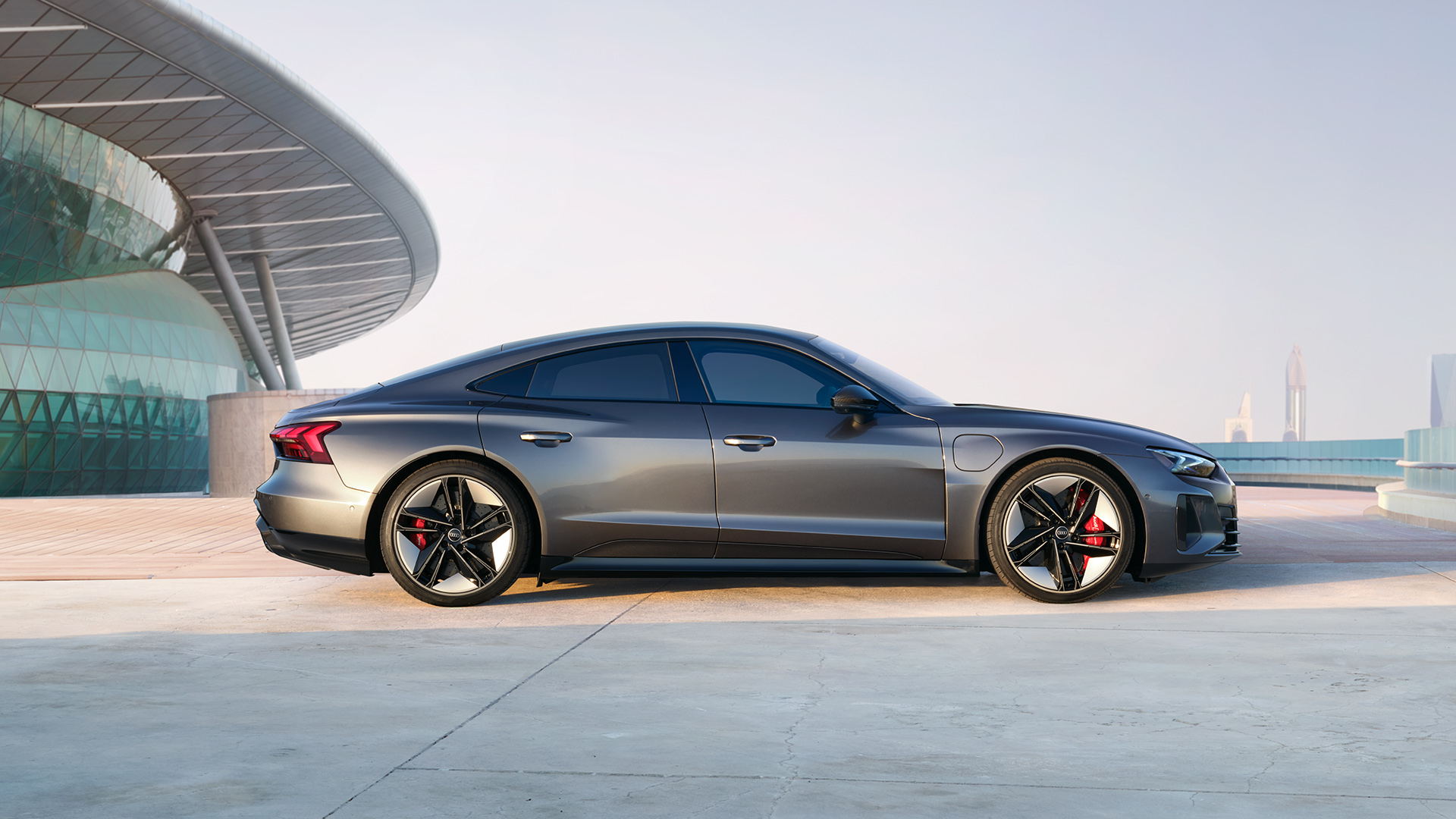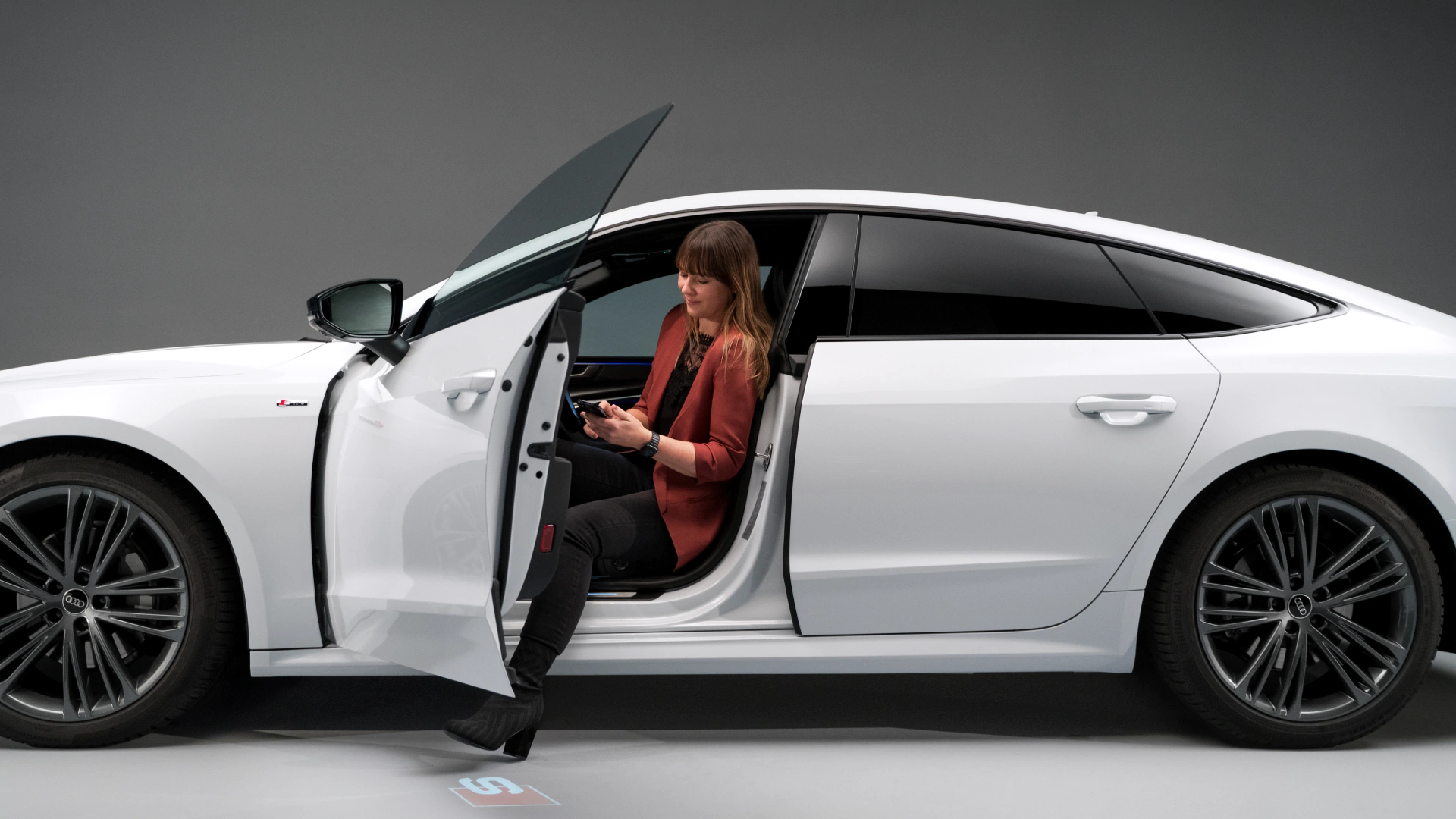Discover how the Audi RS e-tron GT combines aesthetic design and performance.
Power up premium style at the Audi charging hub
Fast charging with a lounge: Audi’s pilot project is a sneak peek at what tomorrow’s urban charging infrastructure for premium e-mobility could look like.
Only consumption and emission values according to WLTP and not according to NEDC are available for the vehicle.

Only Audi customers can reserve the fast-charging stations with an output of up to 320 kilowatts and enjoy the premium lounge at the Audi charging hub.
Only Audi customers can reserve the fast-charging stations with an output of up to 320 kilowatts and enjoy the premium lounge at the Audi charging hub.
The number of vehicles in European cities just keeps rising. As more and more people join the daily commute, parking spots are becoming ever harder to find and unoccupied public charging points are increasingly thin on the ground.
Take Munich, for example. I drive an all-electric car and live just 1.6 kilometres from Marienplatz square in the city centre. But my apartment block doesn’t have basement parking or its own charging station. About 300 metres away, there are four public charging points. A good six months ago, I was able to find a free charging station whenever I needed one.
Those days are over. Now, whenever I make a snap decision to stop by a charging station in the early evening, it’s only to find that all four are once again occupied. So I have to settle for a conventional parking spot. Thirty minutes later, I check the charging app and – hooray – a station is free. I race back to the car, drive to the charging point before turning away in annoyance. Yet again, there’s nothing free. The only thing to do is park once again and hope for better luck later.
Take it slow while fast charging
For people in cities, the fact that charging infrastructure is not keeping pace with the number of newly registered electric vehicles is a harsh daily reality. Finding an available charging station in urban areas can prove to be a serious challenge. What’s more, the fast-charging facilities with higher output that are a familiar sight on motorways are practically unheard of in built-up areas.
This is exactly what the brand with the Four Rings intends to change with the Audi charging hub – a new concept for powering electric cars. Ralph Hollmig, Project Lead for the Audi charging hub, explains: “The basic idea behind the Audi charging hub is to provide for such peaks in demand by means of a reservation function that lets Audi customers book slots in advance.” At present, it’s the luck of the draw in snagging a free station. Looking ahead, Audi customers will be able to book a slot that fits in with their daily schedule rather than hunting for a charging station that happens to be available. But that’s only half the story. There’s another side to the concept. “While waiting for their vehicles to charge, we want our customers to enjoy a premium experience,” says Hollmig.

Ralph Hollmig is Project Lead for the Audi charging hub.
“The reservation function allows Audi customers to book slots in advance.”
Ralph Hollmig

Spanning some 150 square metres, the lounge above the charging points offers amenities that let visitors relax, read up on things, grab a bite to eat or work.
Spanning some 150 square metres, the lounge above the charging points offers amenities that let visitors relax, read up on things, grab a bite to eat or work.
The first lounge is located in Nuremberg
Located in the south of Nuremberg, the first Audi charging hub launched as a pilot project at the end of 2022, offering the chance to pre-book high-power charging (HPC) points and enjoy the comforts of a roughly 150-square-metre premium lounge directly above the stations.
The six HPC points will deliver up to 320 kilowatts of power. Drivers of models such as the Audi RS e-tron GT and the Audi e-tron GT quattro can charge their batteries at an HPC station from five to 80 percent in around 23 minutes. To do so, the Audi RS e-tron GT¹ and Audi e-tron GT² make use of their charging capacity of up to 270 kilowatts. While the battery is being topped up, drivers can choose to take it easy in the lounge over coffee or a snack or work in one of the designated workspace areas.
“Using a data-based approach, we identify locations in areas frequently visited by Audi customers.”
Florian Kehl
What could be more convenient than selecting the Audi charging hub in Nuremberg via the my Audi app, booking the preferred time slot and then spending the short wait time in an inspiring lounge setting? Since the Audi charging hub is part of the public charging infrastructure, anyone can make use of free, unreserved charging points. The booking function is, however, a premium service reserved exclusively for Audi customers.
What criteria does Audi apply in selecting a location such as Nuremberg? As Florian Kehl, Project Lead for Strategic Network Planning, says: “Within urban areas, we basically rely on two search criteria in selecting an Audi charging hub of this kind. Firstly, the site must be on a main traffic artery for customers travelling into the city – for instance, to or from work. On top of that, we look for locations in the city typically frequented by our customers. To that end, we analysed anonymised vehicle data, allowing us to determine which places will best serve Audi customers since we know that many of them are often in the area anyway.”

Florian Kehl is Project Lead for Strategic Network Planning.
“Ninety-two percent of all batteries tested for reuse are suitable for second-life applications.”
Ewald Kreml
Sustainable, modular technology
Dubbed cubes, modular container blocks house fast-charging pillars as well as used lithium-ion batteries from dismantled Audi test vehicles for energy storage, providing the technical core the Audi charging hub. At the Audi charging hub, these can be used, for example, as temporary storage media for the self-generated electricity from the photovoltaic system. Ewald Kreml, Strategic Project Lead for the Audi charging hub, explains: “Ninety-two percent of all batteries tested for reuse still deliver most of their original capacity, making them suitable for second-life applications. Only when batteries can no longer perform this task are they recycled using cutting-edge concepts that permit recovery of the individual raw materials for partial reuse in new batteries.”

Ewald Kreml is Strategic Project Lead for the Audi charging hub.
“The power cube ancillary storage units work on the same principle as a rainwater collection tank.”
Stefan Waltl
At the Audi charging hub, the lithium-ion batteries serve out their second life as ancillary storage units for direct current. This means the Audi charging hub does not require any complex and costly infrastructure, including high-voltage supply lines or transformers. It draws only limited amounts of electricity from the local grid to meet its needs. Supplied via a standard 400-volt high-voltage connection, output of roughly eleven kilowatts per cube is sufficient to fully charge the three storage modules with a total capacity of up to 2.45 megawatt hours overnight. On top of that, photovoltaic cells on the lounge’s roof supply green energy to the ancillary storage units.
Stefan Waltl, Technical Project Lead for the Audi charging hub, adds: “The power cube ancillary storage units work on the same principle as a rainwater collection tank: A little electricity trickles in at the top from the local grid, while we draw a powerful charge from the bottom into the vehicles’ batteries.” The upshot is that the Audi charging hub in Nuremberg will be able to provide around 90 quick charges of up to 320 kilowatts each day.

Stefan Waltl is Technical Project Lead for the Audi charging hub.
The pilot project’s promise for the future
So when can I look forward to an urban fast charging system of this kind going up in my neighbourhood? In reply, Ralph Hollmig says: “As a pilot project, Nuremberg will allow us to test a possible roll-out in practice. Based on the levels of customer acceptance and lessons learned during daily operation, we’ll decide whether to implement the concept.” For now, Hollmig can’t make any promises. So let’s keep fingers crossed that, as is often the case with pilot projects, this one is a sign of bigger things to come.




